Adaptation

An important adaptation of
Photeros annecohenae is its ability to be bioluminescent. This
ability is not only crucial for mating but also extremely
important for the organism in deterring
predators. When preyed
on by plankton-consuming fish or crustaceans, such as the
Cardinalfish, these ostracods
emit a cloud of luminescence lasting as long as a minute both
around and within the predator (James G. Morin 2011). This often
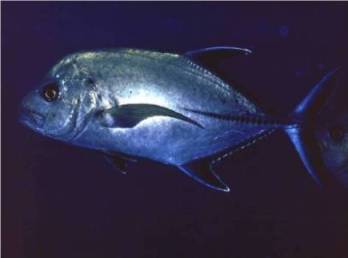 results in the
regurgitation of the ostracod (See below video.) as well as
startles and potentially temporarily blinds the predator.
Most importantly, this sudden luminescence attracts the
predator’s predators (the secondary predators). Because of this,
the ability of Photeros annecohenae to release luminescence when
attacked is termed the “burglar alarm effect" (Morin 1986). Because the
“burglar alarm effect" causes predators of Photeros annecohenae
to be more conspicuous to their own predators, they avoid
consuming the ostracods as well as other organisms that are “ostracod-sized.”
Because male ostracods are luminescent when displaying, they are
invulnerable to predation at these times. The above photo
displays a predator of ostracods.
results in the
regurgitation of the ostracod (See below video.) as well as
startles and potentially temporarily blinds the predator.
Most importantly, this sudden luminescence attracts the
predator’s predators (the secondary predators). Because of this,
the ability of Photeros annecohenae to release luminescence when
attacked is termed the “burglar alarm effect" (Morin 1986). Because the
“burglar alarm effect" causes predators of Photeros annecohenae
to be more conspicuous to their own predators, they avoid
consuming the ostracods as well as other organisms that are “ostracod-sized.”
Because male ostracods are luminescent when displaying, they are
invulnerable to predation at these times. The above photo
displays a predator of ostracods.
It is thought that
the protein luciferin, a component of bioluminescence in ostracods,
initially evolved as a defense (warning to
predators that the ostracod will taste bad). Then, its "matching"
enzyme, luciferase, evolved, allowing for the production of
bioluminescence (Gerrish Personal Communication). This bioluminescence worked better for
predatory defense as well as courtship displays. (Gerrish
and
Morin 2008) This could be seen as
an adaptation to darkness and has lead to species-specific
displays (See photo to left.) that allow for communication about reproductive status
and the presence of a given species. The mating displays are
thought to be an
adaptation to the effect of sexual selection: They allow for
competing males to “wow” potential female mates that are capable of
choosing their male partner (Cohen and Morin 1990).
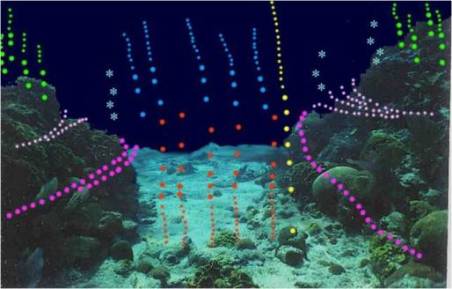 This leads to the species-specific habitats
discussed on the Habitat page. It is
thought that species of
bioluminescent ostracods reside in distinct habitats to make it
easier for females to distinguish their own species' displays
(Gerrish Personal Communication). If many species of bioluminescent ostracod
were displaying in
the exact same place at the exact same time, there would be a
clutter of displays, and one species of female may be distracted by
another species' display. Overall, the courtship routines and,
therefore, mating would not be as a effective or efficient. This
issue is also avoided by the fact that each given species begins
displaying at a distinct time (Rivers and Morin 2009).
This leads to the species-specific habitats
discussed on the Habitat page. It is
thought that species of
bioluminescent ostracods reside in distinct habitats to make it
easier for females to distinguish their own species' displays
(Gerrish Personal Communication). If many species of bioluminescent ostracod
were displaying in
the exact same place at the exact same time, there would be a
clutter of displays, and one species of female may be distracted by
another species' display. Overall, the courtship routines and,
therefore, mating would not be as a effective or efficient. This
issue is also avoided by the fact that each given species begins
displaying at a distinct time (Rivers and Morin 2009).
Another adaptation involving Photeros annecohenae’s
bioluminescent displays is the species' ability to exhibit
“phenotypic plasticity.” (Rivers and Morin 2009) This means that the organism can
quickly adapt physically to changes in the environment. In
bioluminescent ostracods, especially in Photeros annecohenae, this is seen in the shift of ostracods
acting as “leading” signalers ("leaders"),
that begin their mating displays first, entrainers, or signaling ostracods
that begin their displays next to another species member’s display,
and “sneakers,” who do not demonstrate
luminescence but follow closely next to a luminescent male in hopes of
grabbing a female mate (See
Reproduction page for more information.).
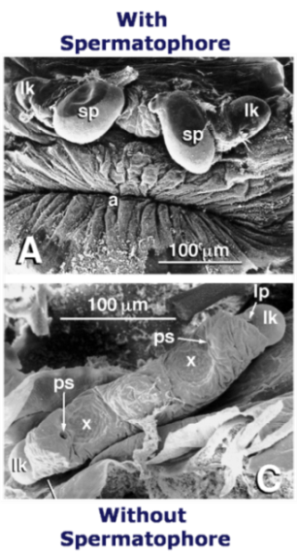 Many morphological adaptations of Photeros
annecohenae revolve around the
process of mating. Males possess a pair of
antennae (first antennae) used to grasp a receptive
female and grip her during mating. It has also been discovered that many of these adaptations enforce
mating only within a given species. For example, a male’s copulatory organ (eighth limb) only fits comfortably inside a
female of its own species. Also, spermatophores, sacs or sperm
which males deposit onto female genitalia to ensure she cannot
mate with another male, are species-specific, meaning the spermatophores of one species of male will not fit into the
genitalia of a different species of female.
Many morphological adaptations of Photeros
annecohenae revolve around the
process of mating. Males possess a pair of
antennae (first antennae) used to grasp a receptive
female and grip her during mating. It has also been discovered that many of these adaptations enforce
mating only within a given species. For example, a male’s copulatory organ (eighth limb) only fits comfortably inside a
female of its own species. Also, spermatophores, sacs or sperm
which males deposit onto female genitalia to ensure she cannot
mate with another male, are species-specific, meaning the spermatophores of one species of male will not fit into the
genitalia of a different species of female.
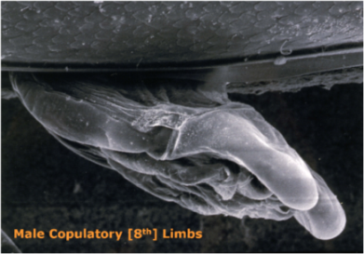
Other physical adaptations include the presence of a
pair of second antennae, with setae attached to the ends, that aid
in locomotion, especially that of swimming. These appendages extend
through an opening in the carapace called the incisur. The pair of
first antennae (used to grasp females during mating) may also be
used as sensory structures to detect chemicals in the current from decaying fish or other food
sources as well as the general environment around the ostracod. These ostracods react well to stimuli. As mentioned on the Classification
and Nutrition pages, the second antennae
are also used to distinguish food from other substances the ostracod
comes across. The
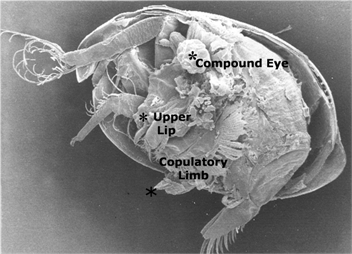 complexity of the compound eye
is also an
extremely important morphological adaptation for Photeros
annecohenae. Eyes this complex are only seen in ostracods that
exhibit bioluminescent courtship behavior and help the species see
and distinguish the displays. They are good detectors of not only
light but distance and contain many ommatidia.
The medial eye detects light levels as well, including
distinguishing between day and night. All ostracods' carapaces are streamlined to allow for easy movement
through the water and contain a keel at
the back to help them stay upright. This chitinous
carapace is an adaptation that protects an ostracod from its predators
by making it more difficult to consume. The
light organ as well as the nozzles present on the organism's
upper lip make bioluminescence possible.
complexity of the compound eye
is also an
extremely important morphological adaptation for Photeros
annecohenae. Eyes this complex are only seen in ostracods that
exhibit bioluminescent courtship behavior and help the species see
and distinguish the displays. They are good detectors of not only
light but distance and contain many ommatidia.
The medial eye detects light levels as well, including
distinguishing between day and night. All ostracods' carapaces are streamlined to allow for easy movement
through the water and contain a keel at
the back to help them stay upright. This chitinous
carapace is an adaptation that protects an ostracod from its predators
by making it more difficult to consume. The
light organ as well as the nozzles present on the organism's
upper lip make bioluminescence possible.
Molting is an adaptation of all
arthropods. Because all arthropods have a chitinous exoskeleton that
covers all of their extremities, they must shed this through the
process of molting in order to get to the next developmental stage.
To learn more about how the adaptation of bioluminescence is used, visit the Reproduction page!
